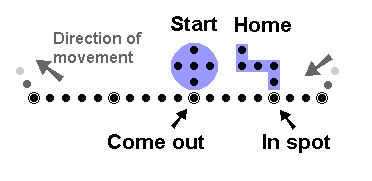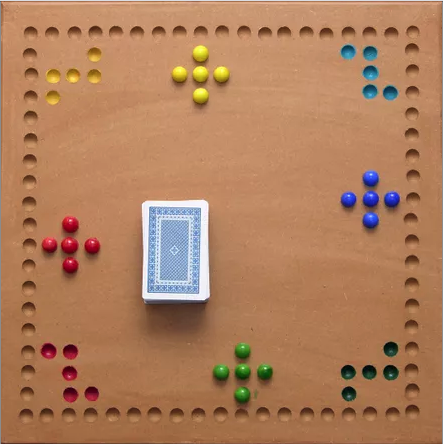Jokers and Marbles - Rules & Strategy Guide
Imagine sitting around a table with friends or family, a colorful game board in front of you filled with winding paths and bright marbles waiting in their "START" positions. Each player, or team if you're playing partners, has five marbles—and the ultimate goal is simple: get all your marbles safely into the "HOME" area before your opponents do. But how you get there? That's where strategy, luck, and teamwork come into play.
At the beginning of the game, a standard deck of playing cards is shuffled and each player is dealt five cards. These cards control how your marbles move—some let you bring a new marble out onto the track, others let you move forward or even backward, and a few allow you to split movement between two marbles. Jokers? They’re the power play—wildcards that can knock an opponent off the board or give you a shortcut to the lead.
You take turns, one at a time, choosing a card from your hand to play. If you can move, you must. A marble can only leave START with an Ace, a face card (Jack, Queen, King), or a Joker. Once your marble is on the track, you start maneuvering it forward based on the cards you draw. Land on an opponent? Their marble goes all the way back to START. Land on your partner? You actually help them—sending their marble closer to HOME, into their IN spot.
But there are restrictions: you can’t land on or jump over your own marbles, and you can’t move backward into HOME. So planning becomes essential. Do you hold onto a Joker for a clutch move later, or play it now to take out an opponent closing in on victory? Do you split your 9 between your marble and your partner’s? Maybe one goes forward, and the other backward, creating just the right opening.
As the game progresses, it becomes a dance of cooperation and tactics. When one player gets all their marbles into HOME, they don’t just sit out—they start playing cards to help their partner. In a true team victory, both players must complete their marbles' journey. Communication, timing, and smart sacrifices can tip the scales.
In the end, the winning team isn’t always the luckiest—it’s the one that plays their cards right, supports their partner, and sees every card as an opportunity, not just a move.
🃏 BASIC GAME OVERVIEW
Goal: Get all your marbles (usually 4 per player) from START to HOME.
Setup:
- Each player starts with 5 marbles in their START area.
- Cards are shuffled and each player is dealt 5 cards.
- After a turn, players draw back up to 5 cards.
- Turns rotate clockwise.
🃏 CARD ACTION CHEATSHEET
| Card | Action |
|---|---|
| A | Bring a peg out of START or move forward 1 |
| 2 | Move forward 2 OR (optional variation) swap with anyone |
| 3–6 | Move forward the number shown |
| 7 | Move forward 7 OR split between 2 pegs (both go forward) |
| 8 | Move backward 8 (not into HOME!) |
| 9 | Move forward 9 OR split 9 between two pegs (one can move backward) |
| 10 | Move forward 10 |
| J/Q/K | Bring a peg out of START or move forward 10 |
| Joker | Wildcard: Replace anyone’s peg with yours. Can bring a peg out like an Ace. |
🔁 MOVEMENT RULES
- You cannot land on or jump over your own peg when moving forward or backward.
- You cannot move backward into HOME (like with 8).
- If you land on an opponent’s peg, it goes back to START.
- If you land on your partner’s peg, it goes to their IN spot.
- Pegs in HOME are safe and can’t be touched.
- You must play a card if it’s playable, even if it’s not beneficial.
- If all your pegs are HOME, your turn is used to help your partner.
🃏 JOKER RULE EXAMPLES
- Joker = powerful: can bring out a peg or replace an in-play peg.
- If you replace:
- An opponent’s peg: it goes to START.
- Your partner’s peg: it goes to their IN spot.
- Example: Use Joker to replace an opponent’s peg 3 spaces from HOME? Now you’re 3 spaces from HOME.
🃏Notes on Strategy
- 8 spaces backward from the start takes you to the corner, which is a risky position to occupy, because you are 10 holes away from your neighbour's come-out hole. So after coming out of Start it is good to begin by moving 1, 2 or 3 spaces forwards. Then 8 spaces backwards will take you to or beyond your in-spot, putting you in a position to go home with less risk of being killed meanwhile by your right-hand opponent.
- If you move 4 or more spaces forward from your come-out hole, moving 8 backward is no longer useful, since this does not reach your in-spot. Your peg now becomes a runner - a peg to be sent on a journey around the board to harass opponents or move into partner's area.
- You can try to set up a home run by positioning your "runner" peg in teammate's come-out hole so that a peg coming out of START lands on your peg and sends it to its in-spot. Even better is the double play: a peg is left in its own come-out hole so that a teammate's arriving runner sends come-out peg directly to its in-spot. Then the next peg to come out of the start area sends the runner to its in-spot. Occasionally it is even possible to set up a longer "chain reaction" in which a series of different colored pegs displace each other in a single move. Also a 7 or 9 could be split to use one part to send a partner's peg to its in-spot and the other part to move that peg home.
- It is important to watch the board! When a player sees a runner approaching a start area, he should position a peg in the adjacent come-out hole to allow a home run.
- 10's and face cards move a peg 10 holes, and there are 64 of these "tens" in the four decks, making 10 the easiest distance to move. So when moving a runner to a partner's area or attacking opponents, it is good to lurk 10 spaces short of partner's come-out hole, or opponent's in-spot. Note also that a peg sitting 10 spaces away from its teammate's come-out happens also to be 8 spaces in front of its opponent's come-out, where it is (almost) safe from attack (since 8's move backwards). Another good place to wait is 3 spaces forward from a peg's come-out. This is 10 away from opponent's in-spot and also within reach of its own in-spot by moving backward 8. Also, when the team only has one peg left in the game and is approaching HOME, they should try to maneuver so the last several moves are 10's.
🃏Common Errors
- Not having enough pegs on the board. 9s, 7s, and (offensive) Jokers need at least two pegs to work. Teams should have a minimum of 2 movable pegs per player on the board at all times (a 4-man team should have 8 pegs!)
- Concentrating on moving into HOME. It is best to wait until an exact count card can be played to move all the way into Home (unless the peg is in imminent danger of being killed). Rely on your partners.
- Getting bound up: one or more pegs in HOME area but not all the way in. This is the Kiss of Death!
- Playing a joker too soon. Hold it until you can get a double or triple play or use it in the endgame to save your team from defeat. Don't be too eager to play it!
- Attacking an opponent instead of putting a teammate into a scoring position. An opponent sent to START is after all only two moves from his home entry space (a face card plus an 8 or 9).
- In the endgame: playing high cards so that the team is too close to enter HOME on an exact count. If you can't go all the way HOME, play your smallest card and give your teammates more chances to enter HOME.
👥 PARTNER STRATEGY
🎯 Main Goal: Get all your team’s pegs HOME (both players).
✅ Key Strategies:
- Get Out Early:
- Prioritize getting pegs out of START with Aces, Jokers, or face cards.
- More pegs in play = more flexibility with splitting moves.
- Work Together:
- Use cards like 7 and 9 to split moves between your pegs and your partner’s.
- Especially useful when you’re helping move their last peg HOME.
- Land on Partner’s Peg (strategically):
- Send it to their IN spot (close to HOME).
- Great if their peg is stuck far away.
- Use the Joker Wisely:
- Best to knock out an opponent close to their HOME.
- Can also swap out a stuck or vulnerable peg.
- Defensive Blocking:
- Leave your pegs in front of opponent’s START or HOME zones to clog their path.
- But don’t block yourself or your partner!
- Forward/Backward Trickery:
- Use 8 or the backward part of 9 to position pegs into better setups.
- Plan around pegs you can’t jump—might need to move others out of the way first.
- Don’t Burn Big Cards Too Early:
- Face cards and Jokers are powerful late in the game to:
- Bring out new pegs quickly.
- Make bold plays when the board is crowded.
- Finish strong or protect your HOME zone.
- Coordinate Turns Late Game:
- Once all your pegs are HOME, help bring your partner’s pegs in.
- Think through each card’s best use: Does it move one of their pegs better than yours?
🏆 HOW TO WIN
- Your team wins when both you and your partner get all your marbles safely HOME.
- You must keep drawing after every turn to maintain 5 cards.
- Once you’re done, play supportively: sacrifice moves to help your partner’s advance.

